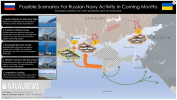Antares
Respected Leader
Täälläkin toisinaan lainatun H.I. Suttonin arvio siitä, mitkä voisivat olla seuraavat "peliliikkeet" Venäjän Mustallemerelle sijoitetun laivaston osalta:

The Russian Navy is largely confined to port, but coming months could see a number of scenarios whereby it becomes more active. Largely these will be forced upon it by Ukraine.
When the invasion started, it was unthinkable that the Ukraine would have the mighty Russian Navy virtually confined to port. Yet since then the Russian Navy has experienced a series of setbacks and emerging threats which has done exactly this.
Ukraine’s sea mines, anti-ship missiles and now ‘maritime drones’ have contributed to them playing a less and less active role. But that is not to say that this will continue this way.
Making firm predictions in war is for fools. But some high-level scenarios can be played out to consider the ways things might go over the next few months.
The first reason for this reversal was anti-ship missiles. These demonstrated their worth against the cruiser Moskva, but it was the arrival of Western supplied Harpoon anti-ship missiles which sealed the deal.
And then in September Ukraine’s indigenous ‘maritime drones’ started showing up. These small uncrewed surface vessels (USVs) are loaded with explosives they are relatively cheap and difficult to counter. We saw the number of patrols reduce and warships avoiding anchoring beyond the protection of the harbor.
The now famous October 29 maritime drone attack they failed to score any major damage. But their threat is real and is likely a primary driver in reshaping Russian naval operations. Now when warships and submarines come and go they are guarded by fast boats and helicopters.
The Russian Navy is not completely absent from the Black Sea. But apart from individual warships and submarines venturing out to launch Kalibr cruise missiles, they are now playing a very low-key role in the war. The priority appears to be on force preservation; exposing themselves to Ukraine’s weapons runs risks for little gain.
The extent and thickness varies by year but we can expect it in the northern Black Sea, near the Kerch bridge and in the Sea of Azov. This could shape, literally, naval operations over the next few months.
However merchant trade was restored in July via political means. Since then Russia has threatened this deal to pressure Ukraine not to attack Sevastopol. But it no longer seems to have the political leverage to do so. If Russia wants to disrupt or stop this trade it now has few options, but those do involve the Navy.
Thanks to Ukraine’s anti-ship missiles, any attempts at a stop-and-search type blockade in the Northern Black Sea would be highly dangerous. This leaves ‘kinetic’ means whereby the ships are physically attacked. Aircraft, warships and submarines could be used. But the perpetrator would be clear and there would likely be a political cost.
So the Russian Navy may consider using covert means to sabotage the ‘grain corridor’. In this scenario ships might be targeted in Sevastopol using limpet mines. Or by carefully laid sea mines outside the harbor. It might be obvious who is doing it, yet it would fall below the threshold of attribution, this limiting political consequences.
Maritime drones, mines, aerial drones and land based short range missiles like British supplied Brimstone could take a toll. And if the ships venture further from shore to avoid these they could sail into a Harpoon trap. But if Ukraine does get a foothold into Crimea Russian commanders may see no choice but to accept the risks.
As the Naval aspects of the war slip out of the headlines, we have to remember that it is not over. The Russian Navy could still find itself sailing into harms way.

The Russian Navy is largely confined to port, but coming months could see a number of scenarios whereby it becomes more active. Largely these will be forced upon it by Ukraine.
Outplayed By Ukraine: What Is Next For Russia’s Navy In The Black Sea?
The Russian Navy is still, on paper, more powerful than its Ukrainian counterpart. But its dominance has been eroded and it is currently mostly confined to port. But things could change. Here are some scenarios to watch for.
H I Sutton 19 Dec 2022When the invasion started, it was unthinkable that the Ukraine would have the mighty Russian Navy virtually confined to port. Yet since then the Russian Navy has experienced a series of setbacks and emerging threats which has done exactly this.
Ukraine’s sea mines, anti-ship missiles and now ‘maritime drones’ have contributed to them playing a less and less active role. But that is not to say that this will continue this way.
Making firm predictions in war is for fools. But some high-level scenarios can be played out to consider the ways things might go over the next few months.
The Current Situation: Fleet In Being
Russia’s naval base at Sevastopol in southern Crimea remains the main naval presence in the war. Despite this Russian Navy warships barely patrol most of the northern Black Sea. This is in stark contrast to the beginning of the war when they were patrolling within sight of Odesa and performing aggressive ‘amphibious demonstrations’ with landing ships.The first reason for this reversal was anti-ship missiles. These demonstrated their worth against the cruiser Moskva, but it was the arrival of Western supplied Harpoon anti-ship missiles which sealed the deal.
And then in September Ukraine’s indigenous ‘maritime drones’ started showing up. These small uncrewed surface vessels (USVs) are loaded with explosives they are relatively cheap and difficult to counter. We saw the number of patrols reduce and warships avoiding anchoring beyond the protection of the harbor.
The now famous October 29 maritime drone attack they failed to score any major damage. But their threat is real and is likely a primary driver in reshaping Russian naval operations. Now when warships and submarines come and go they are guarded by fast boats and helicopters.
The Russian Navy is not completely absent from the Black Sea. But apart from individual warships and submarines venturing out to launch Kalibr cruise missiles, they are now playing a very low-key role in the war. The priority appears to be on force preservation; exposing themselves to Ukraine’s weapons runs risks for little gain.
The Freezing Arena
As the famously harsh Ukrainian winter sets in fighting on land will get slower as soldiers seek warmth before glory. At sea too the winter should be expected to slow things down. The drop in temperatures, combined with local geography will bring with it sea ice.The extent and thickness varies by year but we can expect it in the northern Black Sea, near the Kerch bridge and in the Sea of Azov. This could shape, literally, naval operations over the next few months.
Scenario 1: Restart Attacks On Merchant Ships
One of the Russian Navy’s first moves in the invasion was to blockade Ukrainian ports to stop trade. Russia declared a prohibition on navigation in the North-Western part of the Black Sea down to the parallel 45-21 N from 0400 hours on 24 February 2022. Several third-country merchant ships were then attacked and, while not admitted, there is little doubt who did it. For the first few months this blockade was total.However merchant trade was restored in July via political means. Since then Russia has threatened this deal to pressure Ukraine not to attack Sevastopol. But it no longer seems to have the political leverage to do so. If Russia wants to disrupt or stop this trade it now has few options, but those do involve the Navy.
Thanks to Ukraine’s anti-ship missiles, any attempts at a stop-and-search type blockade in the Northern Black Sea would be highly dangerous. This leaves ‘kinetic’ means whereby the ships are physically attacked. Aircraft, warships and submarines could be used. But the perpetrator would be clear and there would likely be a political cost.
So the Russian Navy may consider using covert means to sabotage the ‘grain corridor’. In this scenario ships might be targeted in Sevastopol using limpet mines. Or by carefully laid sea mines outside the harbor. It might be obvious who is doing it, yet it would fall below the threshold of attribution, this limiting political consequences.
Scenario 2: Pushed To Defend Crimea
If Ukraine advances south from Kherson the Russian Navy may be drawn on to provide direct support to its troops. This could include fire support and ferrying supplies. But the threats to its warships will be severe.Maritime drones, mines, aerial drones and land based short range missiles like British supplied Brimstone could take a toll. And if the ships venture further from shore to avoid these they could sail into a Harpoon trap. But if Ukraine does get a foothold into Crimea Russian commanders may see no choice but to accept the risks.
Scenario 3: Sevastopol Becomes Even More Unsafe
One of the reasons that Russian commanders may commit their warships to the fighting further north is because Sevastopol itself could come into range of systems such as HIMARS. This would be a showstopper and could result in abandonment of the port. Even before then, Ukraine getting more or better weapons able to reach the port will be a serious concern. In these scenarios we could see warships pushed to smaller ports on Crimea’s southern coast. And ultimately Russia’s own Black Sea coast. The other naval base at Novorossiysk is already relatively full so secondary ports would have to be used.Other Points
There are of course numerous other scenarios worth considering. Ukrainian advances reaching the Sea of Azov is of particular interest. This would be similar to scenario 2 (Pushed To Defend Crimea). Another point worth pondering is if Russia may attempt an amphibious landing. The threat of this is now much less than it was months ago, but they do still have landing ships. Overall the prospects of such a move would not be good.As the Naval aspects of the war slip out of the headlines, we have to remember that it is not over. The Russian Navy could still find itself sailing into harms way.





